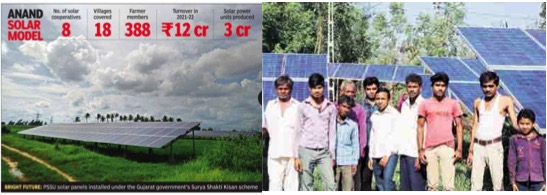Five years ago, Mahesh Manibhai Patel, a farmer with 11 ‘vigha’ land in Gujarat’s Anand district, used to spend sleepless nights because his village got electricity for only eight hours, often late in the evening or at night. Now, he can draw water 12 hours a day in the daytime. He not only gets a good night’s sleep, but also earns a couple of lakh rupees every year by selling surplus electricity.
The revolution in Maheshbhai’s life is part of a new cooperative movement sweeping through Anand, which is home to Amul and the birthplace of India’s White Revolution.
Small Beginning
In 2018, the world’s first solar cooperative – Petlad Sojitra Saururja Utpadak (PSSU) Sahkari Mandali Limited – started in Anand with a seed capital of just Rs 1,100. The idea was to replicate Amul’s cooperative model in the solar energy field. Four years on, PSSU’s turnover has touched Rs 12 crore. More
importantly, it has inspired seven other solar ‘mandalis’ (cooperatives) in a cluster of 18 villages covering 22 sq-km in Anand district.
After meeting the villages’ irrigation needs PSSU has enough solar power left over to supply the state grid. It has also started taking commercial contracts for installing solar panels in the region. PSSU’s three agriculture feeders at Ishnav (Mahesh-bhai’s village), Trambovad and Ashapuri villages generate 24,000 units daily and supply electricity to 388 farmers. In 2019, the Ishnav feeder was India’s first agriculture feeder run by a solar cooperative.
“We had started with the motto to replicate the success that the Amul model has achieved in the milk business. Amul Dairy too started its journey with just 250 litres of milk,” said Tejash Patel, founder and chairman of the PSSU mandali.
“We utilised the Surya Shakti Kisan (SKY) scheme launched by the Gujarat government in June 2018. The SKY scheme enables farmers to generate electricity for their captive consumption and sell the surplus power to the grid. Under the scheme, solar panels are provided to farmersas per their load requirements,” Tejash-bhai said.
Win-Win Formula
The farmers got 30% subsidy each from the Gujarat government and the Ministry of New and Renewable Energy (MNRE). They also got 35% of the funds as a loan from Nabard. They had to pay the remaining 5% themselves, so they took a loan of Rs 3. 5 crore from the Kheda District Madhya Sahkari Bank.
Tejash-bhai said they paid off the loan four months after launching the pilot project. Now the farmers will get free electricity from their solar systems for 22 years and also earn from the sale of surplus units. The cooperative’s members can expect to earn Rs 45,000-Rs 2. 5 lakh per annum from electricity.
Life-Changing Power
The solar movement is changing people’s lives. “Since availability of both electricity and water to irrigate farms was an issue, I used to cultivate only wheat or millets – crops that do not require much water,” Mahesh-bhai said. “But since I have installed a 50hp solar pump, I can draw water for 12 hours during the day. I have started cultivating highyielding crops like tomato, chilli and tobacco, and earn Rs 7. 5 lakh per annum, as against Rs 3 lakh from wheat and millets earlier. ” That’s not counting his earnings from the sale of surplus electricity units.
The solar cooperative is also generating employment. “We have 23 employees, including engineers, who have executed many commercial projects in Gujarat. Our major clients are the dairy cooperative societies of Amul Dairy in Petlad, Sojitra, Tarapur, Khambhat, Umreth and other villages of Anand and Kheda districts, apart from Panchmahals District Agriculture Produce Market Committee and Panchmahals District Co-operative Milk Producers Union Limited,” said Tejash-bhai.



























